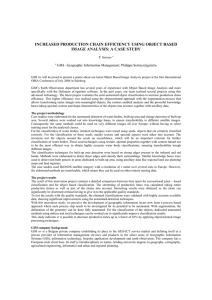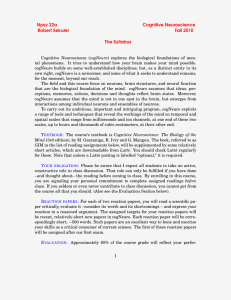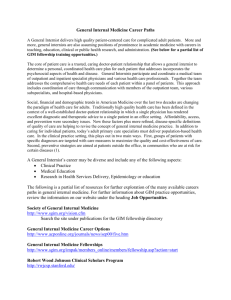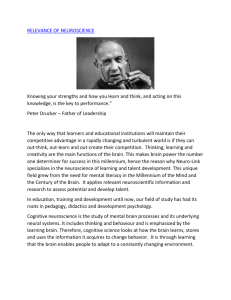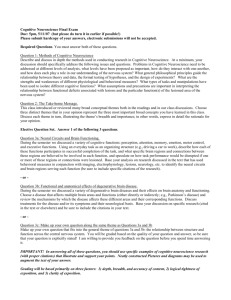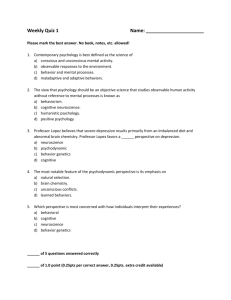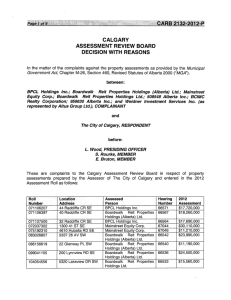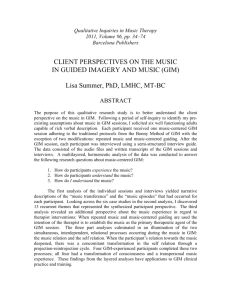syllabus: cognitive neuroscience - University of Southern California
advertisement
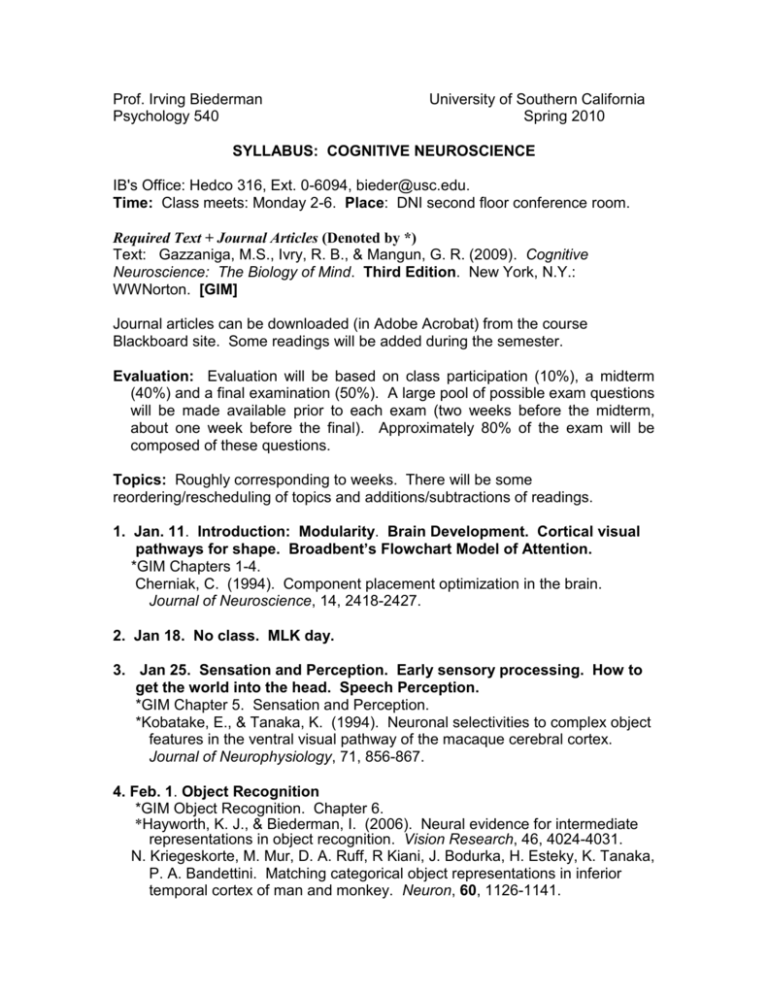
Prof. Irving Biederman Psychology 540 University of Southern California Spring 2010 SYLLABUS: COGNITIVE NEUROSCIENCE IB's Office: Hedco 316, Ext. 0-6094, bieder@usc.edu. Time: Class meets: Monday 2-6. Place: DNI second floor conference room. Required Text + Journal Articles (Denoted by *) Text: Gazzaniga, M.S., Ivry, R. B., & Mangun, G. R. (2009). Cognitive Neuroscience: The Biology of Mind. Third Edition. New York, N.Y.: WWNorton. [GIM] Journal articles can be downloaded (in Adobe Acrobat) from the course Blackboard site. Some readings will be added during the semester. Evaluation: Evaluation will be based on class participation (10%), a midterm (40%) and a final examination (50%). A large pool of possible exam questions will be made available prior to each exam (two weeks before the midterm, about one week before the final). Approximately 80% of the exam will be composed of these questions. Topics: Roughly corresponding to weeks. There will be some reordering/rescheduling of topics and additions/subtractions of readings. 1. Jan. 11. Introduction: Modularity. Brain Development. Cortical visual pathways for shape. Broadbent’s Flowchart Model of Attention. *GIM Chapters 1-4. Cherniak, C. (1994). Component placement optimization in the brain. Journal of Neuroscience, 14, 2418-2427. 2. Jan 18. No class. MLK day. 3. Jan 25. Sensation and Perception. Early sensory processing. How to get the world into the head. Speech Perception. *GIM Chapter 5. Sensation and Perception. *Kobatake, E., & Tanaka, K. (1994). Neuronal selectivities to complex object features in the ventral visual pathway of the macaque cerebral cortex. Journal of Neurophysiology, 71, 856-867. 4. Feb. 1. Object Recognition *GIM Object Recognition. Chapter 6. *Hayworth, K. J., & Biederman, I. (2006). Neural evidence for intermediate representations in object recognition. Vision Research, 46, 4024-4031. N. Kriegeskorte, M. Mur, D. A. Ruff, R Kiani, J. Bodurka, H. Esteky, K. Tanaka, P. A. Bandettini. Matching categorical object representations in inferior temporal cortex of man and monkey. Neuron, 60, 1126-1141. Biederman: PSYCH 540 Cognitive Neuroscience Spring 2009 Syllabus Page 2 *Ullman, S. (2007). Object recognition and segmentation by a fragment-based hierarchy. TICS, 11, 58-64. *Freedman, D. J., Riesenhuber, M., Poggio, T., & Miller, E. K. (2003). A Comparison of Primate Prefrontal and Inferior Temporal Cortices during Visual Categorization The Journal of Neuroscience, 23, 5235–5246. 5. Feb. 8.. Attention & Consciousness. The Control of Action. *GIM. Chapter. 12. Attention & Consciousness *GIM. Chapter 7. The Control of Action. *Sheinberg, D. L., & Logothetis, N. (1997). The role of temporal cortical areas in perceptual organization. PNAS, 94, 3408-3413. 7. Feb. 15. No Class. President’s Day. 8. Feb. 22. Learning and Memory. Clive Wearing. *GIM. Chapter 8. *Polyn, S. M., & Kahana, M. J. (2008). Memory search and the neural representation of context. Trends in Cognitive Science, 12, 24-30. *Bakker, Kirwan, Miller, & Stark. (2008). Pattern separation in the human hippocampal CA3 and dentate gyrus. Science, 319, 1640-1642. 9. March 1. Frank Manis. Reading & Dyslexia. Language. Syntax. *Chapter 10. Language. 10. March 8. More language. Hemispheric Specialization and Concepts. Distribution of midterm question pool. *GIM Chapter 11 Hemispheric Specialization. *Golinkoff, R. M., & Hirsh-Pasek, K. (2008). How toddlers begin to learn verbs. TICS. *Mitchell, T. M. et al. (2008). Predicting Human Brain Activity Associated with the Meanings of Nouns Science, 320, 1191. 11. March 15. No Class. Spring Recess. 12. March 22. Midterm Exam. 13. March 29. Emotion. *GIM. Chapter 9. *Tsuchiya, N., & Adolphs, R. (2007). Emotion and Consciousness. TICS, 11, 159-167. *Murray, E. A. (2007). The amygdala, reward and emotion. TICS, 11, 489497. 14. April 5. Working Memory and Cognitive Control. *GIM. Chapter 13. Biederman: PSYCH 540 Cognitive Neuroscience Spring 2009 Syllabus Page 3 *Badre, D. (2008). Cognitive control, hierarchy, and the rostro-caudal organization of the frontal lobes. Trends in Cognitive Science, 12, 193-200. 15. April 12. Social Cognition *GIM. Chapters 14. Social Cognition *Donalson, Z. R., & Young, L. J. (2008). Oxytocin, Vasopressin, and the neurogenetics of sociality. Science, 322, 900-904. 16. April 19. Antonio Damasio. Consciousness and Self; Social Cognition Network 17. April. 26. (Last Class.) Evolutional Psychology and Behavioral Genetics. Love, Individual Differences, Personality, and Intelligence. Distribution of final question pool. *GIM. Chapter 15. Evolutionary Perspectives. *Bouchard, T., Lykken, D.T., McGue, M., Segal, N. L., & Tellegen, A. (1990). Sources of human psychological differences: The Minnesota study of twins reared apart. Science, 250, 223-228. *Haidt’s, J. (2007). The new synthesis in moral psychology. Science, 316, 998-1002.
